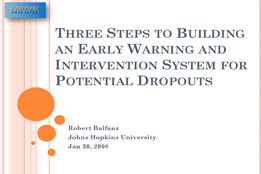Early Warning and Response Systems
Early warning systems use readily available data to alert teachers and administrators to students who are on the pathway to dropping out. A key benefit of early warning systems is that they help educators to know what to look for amid the mountains of data about students. Early warning systems can be implemented at the middle and high school levels – even as early as 6th grade. Researchers from the Everyone Graduates Center found that more than 50% of the dropouts in Philadelphia could be identified in eighth grade using just three indicators:
1) failing mathematics in eighth grade,
2) failing English in eighth grade, and
3) attending school less than 80% of the time.
What does it take to develop an early warning system?
An ideal early warning system for a district is developed from that district’s data. At a minimum, creating an early warning system involves:
- Assembling longitudinal data for individual students on a) graduation status and b) potential predictors of dropout, such as student attendance, behavior, grades, and test scores;
- Identifying the threshold level of each predictor that gives students a high probability of dropping out; and
- Checking that the predictors identify a high percentage of the students in that district who drop out of school.
 The Everyone Graduates Center provides technical assistance and customized analyses to school districts and states that are interested in developing early warning systems.
The Everyone Graduates Center provides technical assistance and customized analyses to school districts and states that are interested in developing early warning systems.
If you are looking to get started, please follow this link for EGC’s Indicators & Interventions: A Practical Manual for Early Warning Systems.
Additionally, districts with the capacity to analyze their own student data may be able to use the Early Warning Indicator tool developed by the National High School Center.

Designing Education S3, E3 Diving Deep into the Four Components of a Student Success System
In the third episode of season three, Tara Madden, Chief Program Officer of Talent Development ...
More Information...
On Track to Career Success
Insights from a Pandemic: Reflections from the On Track to Career Success Project After extensive planning ...
More Information...
The Education of Omarina – The Story Continues
In PART THREE of The Education of Omarina, FRONTLINE continues the story they have been following since 2012. The story ...
More Information...
Want To Make A School Better?
Bob Balfanz cites chronic absenteeism as “the biggest thing in school improvement that people have ...
More Information...
Getting Back on-Track: Early Warning Indicator Analysis of High School & Post-Secondary Outcomes San Jose Unified School District
This study was conducted by the Everyone Graduates Center (EGC) of the School of Education, ...
More Information...
Schools Battle Chronic Absenteeism – CNN
(CNN) - Millions of students are chronically absent. CNN's Athena Jones looks at what schools ...
More Information...
Learning What it Takes
Growing alarm over high dropout rates has created a groundswell of interest in ways to ...
More Information...
An Early Warning System
This article for practitioners summarizes work by Everyone Graduates researchers on early indicators of dropout. [ribbon]Summary[/ribbon] We ...
More Information...
Three Steps to Building an Early Warning and Intervention System for Potential Dropouts
Most dropouts are identifiable years before they dropout, struggle in or disengage from school for ...
More Information...Copyright © 2023 - Every1Graduates.org at the Johns Hopkins University's School of Education - All rights reserved. Conforms to W3C Standard XHTML & CSS
